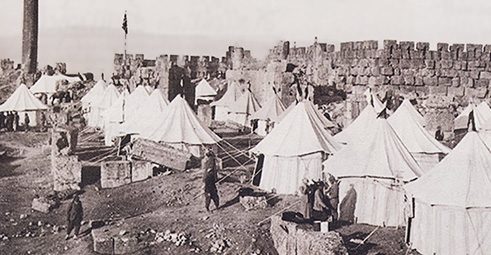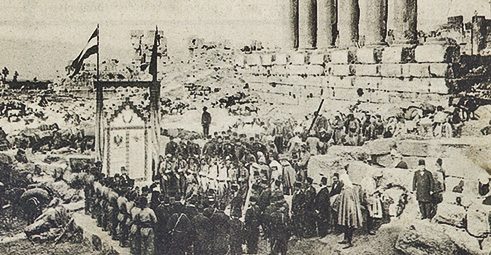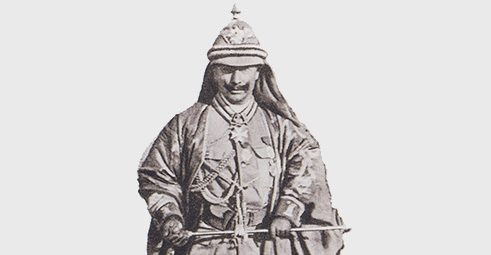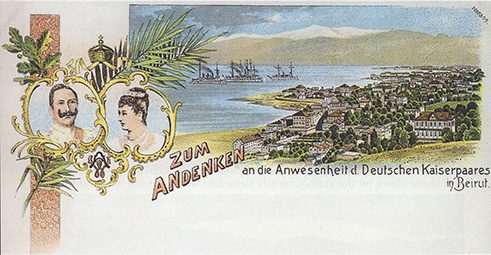Traces of Germany in Lebanon
Kaiser Wilhelm II: The ‘Travelling Emperor’ in Baalbek
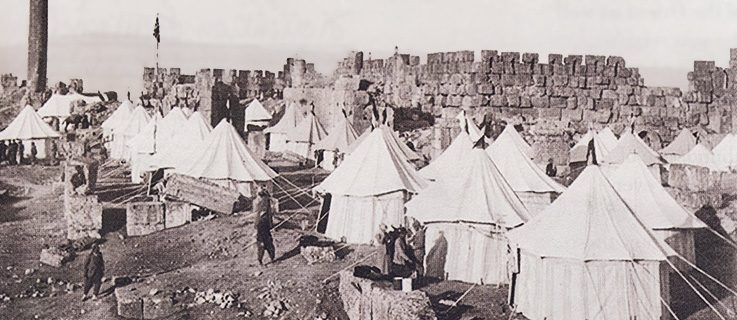
It’s no secret that Kaiser Wilhelm II enjoyed travelling. In times of peace the head of state was rarely to be found in Potsdam or Berlin; more often he resided in one of the German spa towns or ventured out on extended journeys within Europe. In 1898, during his second journey to the Orient, which wasn’t without its critics within the Empire, Wilhelm also stopped off in Baalbek.
The Lebanon Railway was the Emperor’s first choice of transportation within the country. It was a new service that had only commenced three years previously, connecting Beirut to Damascus on narrow tracks and running on a rack rail in some places. In a departure from the official travel plan, the royal yacht MS Hohenzollern and the three ships escorting it had first anchored on the morning of 5 November in the Port of Beirut. The Kaiser’s official travel chronicle painted the following picture:
(Das Deutsche Kaiserpaar im Heiligen Lande [The German Imperial Couple in the Holy Land], p. 341)
Wilhelm and Augusta Viktoria and their entourage also spent the following day in Beirut. Although Lebanon was under French influence, Wilhelm was received with great enthusiasm by the population and notables – at least if the sources are to be believed. On 7 November, the imperial couple and their entourage were accompanied to the station of the Lebanon Railway in a triumphant procession. The first destination was Aley. The official travel chronicle recounts:
(Das Deutsche Kaiserpaar im Heiligen Lande [The German Imperial Couple in the Holy Land], p. 346f.)
From Aley, the journey continued to the Beqaa Valley and onwards on the Lebanon Railway through Muallaqa near Zahle all the way to Damascus, where Wilhelm not only paid respect to Saladin’s grave and endowed it with a new sarcophagus, but also proclaimed himself a friend to Muslims. On 10 November their imperial majesties started their return journey on the chartered train. In Muallaqa, Wilhelm was greeted by ladies of honour dressed in white and wearing sashes in the imperial colours. The onward journey to Baalbek had to be undertaken by horse and carriage and this was done “en grande pompe”, as the French-language newspaper Hadikat-el-Akhbar reported on 17 November 1898. The travel party arrived in Baalbek in the early evening.
After a short night at a campsite set up in the middle of the ancient city, the monarch visited the impressive remains of the temples in the early morning. At the same time he inaugurated two marble panels that now, due to the pile of rubble that lay there at the time, hang a few metres above ground level on a side wall of the temple of Bacchus.
The imperial couple then continued their journey to Beirut by train from Muallaqa. Back in Beirut, a triumphant reception once again awaited the travel party:
(Das Deutsche Kaiserpaar im Heiligen Lande [The German Imperial Couple in the Holy Land], p. 378)
In his article, Thomas Scheffler writes that a song that emerged during the Kaiser’s visit remained popular with Beirut’s harbour workers for many years after. The words to the song were as follows:
(Thomas Scheffler: Vor hundert Jahren: Wilhelm II. im Libanon – Stationen und Zitate [A Hundred Years Ago: Wilhelm II in Lebanon – Stops and Quotes], p. 155)
Guests at the Palmyra Hotel in Baalbek may be surprised to find that the Kaiser’s visit is commemorated to the present day, even featuring a statue of the monarch.
